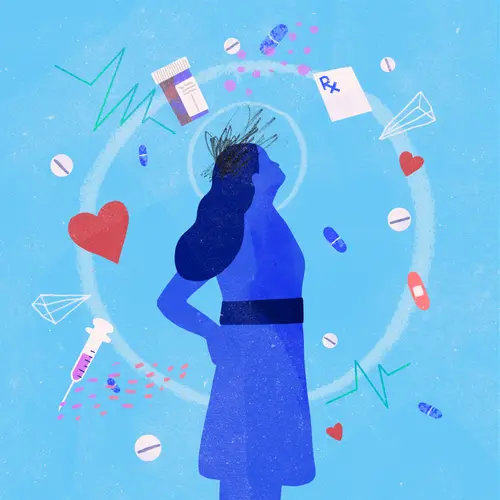Phlegm. Mucus. Sputum. These are different names for the slimy, slippery stuff that flows out when you cough, sneeze, or sniffle.
This gunk is your body’s defense weapon against infectious microbes and allergens that irritate your lungs or sinuses. The color and texture can vary widely, from clear sticky strings to stretchy yellow messes to thick green clots.
Brown phlegm is less common. Here are some reasons why you might get it.
It can be a sign of old blood, chronic -- ongoing -- inflammation, or tar that loosens up after you’ve quit smoking.
COPD
Chronic obstructive pulmonary disease happens when your lungs get so swollen over time that air can’t flow freely. Cigarette smoke is usually the reason. You might cough, wheeze, and have trouble breathing. If your mucus turns brown, yellow, or green, it can be an early warning sign of a flare-up. It’ll be stickier and thicker, and there’ll be more of it.
Treatments for COPD include medications, pulmonary rehab, supplemental oxygen, and surgery to open up blocked pathways. In severe cases, you may need a lung transplant.
Acute Bronchitis
This is when the linings of your bronchial tubes, the air passageways in your lungs, get inflamed. Viral infections are the most common cause of acute bronchitis. But it also can be brought on by bacteria, an irritant such as smoking, an allergy, or certain chemicals.
If you have it, you’ll first notice a cough. It could be dry or bring up phlegm. The mucus can range from clear to cloudy, brown, yellow, or green. Your chest might feel tight or tender. Other signs are a fever, tiredness, shortness of breath, a sore throat, and a stuffy nose.
Bronchitis usually goes away on its own. Your doctor might suggest ways to thin out your mucus to make it easy to cough up. You can run a vaporizer, stand in a hot shower, or hover over a steam tent over hot water. If your symptoms don’t go away and your doctor strongly suspects a bacterial infection, they may prescribe an antibiotic.
Bacterial Pneumonia
A dry cough that brings up thick phlegm is one of the main symptoms of pneumonia. The mucus might be yellow, green, red, brown, or rust-colored. Sometimes the color can be a tip-off of the type of bacteria that caused the illness.
Pneumonia starts with tissue swelling in one or both of your lungs. The tiny grape cluster-like air sacs at the tips of your breathing tubes can swell and fill up with fluid. You’ll need antibiotics to treat bacterial pneumonia.
Chronic Lung Disease
This term includes a wide range of lung disorders that don’t go away or worsen over time. They can be hereditary, be triggered by things in the environment, or start with a habit like smoking.
Two forms of chronic lung disease, cystic fibrosis (CF) and bronchiectasis, might lead you to cough up clingy, dark-brown phlegm.
Cystic fibrosis. People with CF are born with a faulty gene that makes their mucus very thick and sticky. Instead of lubricating, the phlegm clogs the lungs and holds onto germs that lead to lingering infections. Adults with CF often may cough up mucus that’s tinged with blood. That can happen if repeated infections irritate a small blood vessel.
CF is a lifelong condition. Treatment includes techniques to keep the airways clear and break up mucus, inhalers, antibiotics, enzyme supplements, and targeted fitness programs that boost energy and help your lungs work better.
Bronchiectasis. This happens if the airways that join your windpipe to the lower part of your lungs are too wide. Mucus can build up and make you more likely get lung infections. Bronchiectasis can result from such conditions as childhood whooping cough, pneumonia, severe asthma, and COPD. A main symptom is mucus in a variety of shades, from white to brown.
Since bronchiectasis is a long-term condition, you may need to stay on inhalers and other drugs to lower your swelling. Antibiotics and flu vaccines can help prevent infections.
Fungus Allergy
Aspergillus is a fungus that’s widely found in soil, plants, and rotting vegetation. If you’re allergic and breathe it in, it can inflame your lungs. You might wheeze and cough up brown-flecked mucus. You might get a fever. If you have cystic fibrosis or asthma, you’re more likely to have this allergy. If so, your doctor will call it allergic bronchopulmonary aspergillosis.
Your doctor may prescribe medications that help tame inflammation, as well as antifungal drugs.
Lung Abscess
This is a painful pocket of pus wrapped in inflamed tissue. It can happen if the bacteria in your mouth or throat, such as from gum disease, gets down to your lungs. If you can’t cough it out, infection can set in and form a cavity.
Your symptoms will start slowly. You might feel tired, have night sweats or fever, and cough up foul-smelling, brown- or blood-specked phlegm. You’ll need a course of antibiotics over at least a few weeks to clear it up.
Quitting Smoking
Within a week after your last cigarette, your lungs start cleaning themselves. Smoke slows down the tiny cilia that sweep mucus from your lungs. Once they can do their job right, you might start to cough up brown mucus from the tar you’ve inhaled over time. This might go on for a few weeks. You can help get rid of it faster by drinking lots of fluids and running a humidifier or vaporizer to help moisten and thin out your phlegm.
If your cough lasts more than a month or if you see blood, see your doctor.
